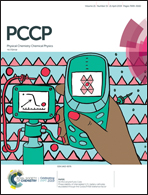Towards capturing cellular complexity: combining encapsulation and macromolecular crowding in a reverse micelle†
Abstract
Confinement and macromolecular crowding are acknowledged to be fundamental for the understanding of biomolecular systems. This computational study combines these two phenomena by investigating a multi-protein system encapsulated in a reverse micelle. Contemporary controversies regarding force field accuracy with respect to hydration in such systems were addressed by scaling the non-bonded, non-charged interaction of water with the surfaces, i.e. protein and surfactant (λ-scaling). While based on extensive atomistic simulations, our analysis is of mesoscopic nature with a focus on dielectric properties since recent experimental studies have gained insight on protein mutual orientation via dielectric permittivity. We find two dielectric mechanisms, one allowing for parallel and orthogonal protein dipole alignment while the other leads to preferred anti-parallel alignment. Which mechanism actually occurs is decided by the degree of hydration of both the proteins and the capsule interface. We raise the question whether the findings for reverse micelles can be transferred to biological cells. The embedding in the highly polar outside medium plays an important role in the answer.



 Please wait while we load your content...
Please wait while we load your content...